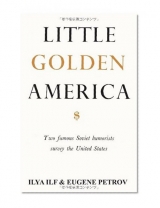
Текст книги "Little Golden America"
Автор книги: Евгений Петров
Соавторы: Илья Ильф
сообщить о нарушении
Текущая страница: 9 (всего у книги 28 страниц)
Although it was the end of 1935, all of Dearborn and Detroit were full of the advertising samples of the 1936 models. They stood in hotel vestibules, in the stores of the dealers, even in the show windows of drugstores and confectionery shops, among cakes, syringes, and cigar-boxes. Automobile wheels turned on thick Firestone tires. Mr. Henry Ford made no mystery of his production. He displayed it wherever he could. In his laboratory, however, stood the one sacred object—Model 1938, concerning which the most contradictory rumours were afloat.
In that model the motor was presumably located at the rear, there was presumably no radiator, the coupe presumably was twice as large, and, in brief, all of it was a thousand and one automobile nights. For the time being no one was to see it, certainly not the General Motors people who, a few miles from Ford, manufacture Chevrolets, machines of the Ford class.
Our permit was granted very quickly. The management placed at our disposal a Lincoln for guests, in which there was even a bear rug, evidently because of the desire to provide the guests from the distant North with surroundings as close and native to them as possible. With the Lincoln were a chauffeur and a guide. We drove into the factory yard.
Along a glass-covered gallery which connected two buildings, in the yellowish light of day, slowly floated automobile parts hung on conveyor chains. This slow, stubborn, irrevocable movement could be seen everywhere. Everywhere, overhead, on the level of the shoulder or almost at the level of the floor rode automobile parts—stamped sides of hoods, radiators, wheels, motor blocks; sand forms in which the liquid metal still shone; brass horns, lights, fenders, steering wheels, gears. They either went up or came down or turned the corner. At times they came out into the fresh air and moved under a little wall, swaying on their hooks like the bodies of sheep. Millions of objects floated simultaneously. It took one's breath away to behold this spectacle.
This was no factory; this was a river, sure of itself, a trifle deliberate, which increases the rate of its flow as it reaches its mouth. It flowed day and night, in inclement weather and on sunny days. Millions of parts were carried by this river to one point, where the miracle happened– the hatching of an automobile.
On the chief Ford conveyor the work proceeds with feverish speed. We were amazed by the gloomy and worried appearance of people busy at a conveyor. Their work absorbed them completely. There was not even time enough to raise their heads. But it was not only a matter of physical fatigue. These people seemed to be depressed in spirit, seemed to be overcome at the conveyor with a state of daily madness that lasts for six hours, after which, upon returning home, they must rest for a long time, get well, recuperate, in order on the next day again to grow mad for a while.
The work is so divided here that the men on the conveyors don't know how to do anything, have no professions, no trades. Workers here do not manage the machines; they merely tend them. Therefore, one does not see here that sense of self-esteem which is found among trained American workers with a trade. The Ford employee receives a good wage. He himself represents no technical value. Any minute he can be dismissed, replaced by somebody else. In twenty-two minutes his successor will learn to manufacture automobiles. Working for Ford gives a man a livelihood, but does not raise his qualifications and does not assure his future. That is why Americans try not to work for Ford; and when they do, they go as mechanics or as clerks. The men who work for Ford are Mexicans, Poles, Czechs, Italians, Negroes.
The conveyor moves. One after the other excellent cheap machines roll off. They drive through the wide gates into the world, into the prairie, into freedom. The people who have made them remain behind, in confinement. Here is an astounding picture of the triumph of technique and the misfortune of man.
Down the conveyor came automobiles of all colours—black, Washington blue, green, gun-metal (so they are officially designated), even, oh, oh, of a sedate mouse colour. There was one bright orange hood, apparently a future taxi.
Through the commotion of assembly and the clatter of automatic bolt wrenches, only one man maintained a grandiose calm. He was the painter whose duty it was to draw with his thin brush a coloured line around the hood. He had no accessories, not even a maulstick, to hold up his arm. On his left arm hung little jars with various pigments. He was in no hurry. He even had the time to regard his work with an appraising glance. Around the mouse-coloured automobiles he passed a green stripe. Around the orange taxi he passed a blue stripe. He was a free artist, the only man in a Ford factory who has no relation to technique, a kind of Nuremberg Meistersinger, a freedom-loving master of the paint shop. The Ford laboratory must have discovered that it paid best to have these stripes drawn in this medieval way.
A bell rang out. The conveyor stopped. Little automobile trains with lunch for the workers drove into the building. Without washing their hands, the workers walked up to the little wagons, bought their sandwiches, tomato juice, oranges, and sat down on the floor.
Mr. Adams suddenly came to life. " Gentlemen, do you know why in Mr. Ford's plant the workers have their lunch on the cement floor? This is very, very interesting! It is of no moment to Mr. Ford how his workers lunch. He knows that the conveyor will compel them to do their work irrespective of where they eat, on the floor, at a table, or don't eat at all. Take, for example, General Electric. It would be foolish to think, gentlemen, that the management of General Electric loves its workers more than Mr. Ford does; maybe, even less. Nevertheless, it has excellent dining-rooms for its workers. The point is that at General Electric are employed qualified and trained workers, and one must take their wishes into consideration. They might go away to another factory. It is a purely American characteristic not to do any more than necessary. Don't doubt for a moment that Mr. Ford regards himself as a friend of the workers; but he will not spend one extra penny on them."
We were invited to sit down in a machine that had just come off the line. Each machine drives around a special factory road two or three times as a test. This is in a sense a model bad road. One could drive all over the United States and not find such a road. As a matter of fact, the road was not so very bad. A few regular dips, a small, rather attractive puddle—that was all there was to it—nothing frightful.
The automobile made before our eyes by people who have no trade exhibited remarkable qualities. It made sharp turns at a speed of fifty-five miles an hour, was very steady, in third gear went no faster than five miles an hour, and took the dip as gently as if there were no dip at all.
"Yes, yes!" Mr. Adams said exultantly. "Mr. Ford knows how to make automobiles. You do not even begin to appreciate progress made in this business. A 1935 Ford is better than a 1928 Cadillac. In seven years the machine of the cheap class has become better than the machine of the best class. Write that down in your little book, Mr. Ilf and Mr. Petrov, if you want to know what America is."
Here not only flowed parts combining into automobiles, and not only automobiles flowed out of the factory gates in an uninterrupted line, but the factory itself changed constantly, improved upon itself, and augmented its equipment.
In the foundry, Comrade Grozny suddenly began to cackle enthusiastically. He had been here less than two weeks, and in that time serious and important changes had occurred in this department. He stood in the middle of the shop, and on his face, lighted by flares of fire, was reflected such elation that none but another engineer, a real engineer, not an engineer of human souls, could appreciate fully and understand him.
The yellowish-grey day soon passed into a yellowish-black twilight. When we were leaving the factory a tremendous number of completed automobiles were already standing in the yard, and among them somewhere in the centre we noticed the bright orange taxi which a little while ago had been moving along the conveyor.
In a barber shop on Michigan Avenue, where we had our hair cut, one barber was a Serbian, another was a Spaniard, a third was a Slovak, while a fourth was a Jew born in Jerusalem, which might be deemed a joke of nature. We dined in a Polish restaurant, where we were waited upon by a German girl. The man whom we asked for directions in the street did not speak English. He was a Greek who had arrived here recently, right into the devil's own hell, from the Peloponnesus. He had the sad black eyes of a philosopher in exile. At the cinema we suddenly heard in the darkness this sentence spoken out loud: "Manya, I told you that we should not have come to this picture."
"Here, gentlemen," said Mr. Adams, "now you are in the real America."
In the morning we called on Mr. Sorensen, manager of all the Ford plants scattered throughout the world.
We passed through a hall, on the clean hardwood floor of which were spread out the parts of a standard automobile. Just as we were, in our hats and coats, we were led into the glass-enclosed office of the manager. Here stood a large desk. There was not a single piece of paper on it—only one telephone and a calendar. We wanted to find out as soon as possible what occupies the time of a manager who does not sign any papers, who does not ply the telephone morning, noon, and night, a manager in whose anteroom, instead of even a single visitor, lie oiled machine parts.
A tall thin man in a grey suit entered the office. His head was grey, his face was ruddy, and his walk was that of an athlete. In his hand was a small black object made of some plastic. This was Mr. Sorensen, a Dane by descent, the son of a stove-setter, himself at one time a stove-setter but later a patternmaker.
Before we left America we read in a Washington newspaper a list of the ten people who received the highest salaries in the country that year. Mr. Sorensen was in the last place. The first place was occupied by Mae West, the motion-picture star. In 1935 she was paid $450,000. Sorensen received $112,000. Needless to say, the head and hands of this man are infinitely more valuable than the pornographic bosom of any film star.
Lie at once began to talk about the machine part he held in his hand. At one time it used to be made of steel; now it is made out of plastic pad tested at once.
"We are constantly on the move," said Mr. Sorensen. "Therein lies the essence of the automobile industry. We cannot stop for a minute. Otherwise we shall be left behind. We must think now of what we shall he doing in 1940."
He stepped out of the room and at once returned with a mould in his hands. That was the block of a motor he had himself cast in mould out of steel—with his own managerial hands.
"We will be testing this for a long time. But it looks as if this might be a part of our automobile."
We touched the block cast that would be part of a machine a few years hence, and began to talk about Ford.
"I met Mr. Ford thirty-five years ago," said Sorensen.
"What are your relations today?"
"Oh," said Mr. Sorensen, "thirty-five years ago Mr. Ford built his automobile in some barn and came to me in the small foundry where I was working. At that time he was an ordinary mechanic, while I was a patternmaker. He brought me his blueprint and asked me to make a model. And nothing has changed since that day. To this day Mr. Ford brings me his ideas and I put them into practice."
He said that nothing had changed. Yet even the most cursory glance could see the progress that had been caused by a little Dearborn mechanic and his young friend, the patternmaker.
Mr. Sorensen led us to a photograph showing him together with the manager of the Gorky factory, Dyakonov, and with Grozny. Smiling artlessly, the three men were looking straight into the camera.
"There is only one permanent thing in this world," Mr. Sorensen told us in parting—"incessant change."
We managed to squeeze into our conversation the notion that we should like to see Mr. Ford, and Mr. Sorensen said that he would find out whether that was possible. However, we were not certain that the interview would actually occur. Everyone had warned us that this was very difficult, that Mr. Ford is old, busy, and unwilling to meet people.
16 Henry Ford
IN THE morning Mr. Sorensen telephoned to say that Mr. Ford would receive us. Again we had proof that Americans are meticulous and businesslike. As a matter of fact, Mr. Sorensen did not promise anything and had every moral right never to refer to the matter again. He regarded the most casual remark as important business as any contract signed by him.
We were asked to drop in on Mr. Cameron, Mr. Ford's private secretary. Mr. Cameron was located in the construction bureau building.
"Mr. Ford is not here now," he informed us, "and I cannot tell you exactly when you will be able to see him. But you are looking over the factory anyway and are likely to drive past our office at least ten times in the course of the day. Whenever you drive by, drop in to find out whether Mr. Ford happens to be in at that time."
We already knew that Mr. Ford has no office of his own, did not lock himself in, but is constantly on the go through the plant. We were, therefore, not at all surprised to hear this, and, covering ourselves with the bear rug, we drove off through the wonders of Dearborn.
We began that day with the machine museum.
One of the halls of the museum building covers twenty acres. The floor is of teakwood, which rings underfoot like steel. The hall is supported by metal columns. They are at the same time the heating apparatus.
The museum was not yet finished, but remarkable exhibits are brought here from all over the world. Here are scores of steam-engines and machines, beginning almost with Watt's boiler. All the machines are set in foundations, so that after the opening of the museum they will be able to perform, actually demonstrating ancient technique. Among them are extraordinarily elaborate models—clumsy, heavy, on cast-iron Corinthian columns, painted with green oil paint. The automobile department is tremendous. Here evidently have been assembled all the types and models of automobiles that have ever existed anywhere in the world. And it cannot be said that a conception of beauty was foreign to the builders of automobiles of thirty years ago. Of course, almost all these machines seem strange to our eye today. Yet among them are some beautiful examples. Here is a lot of red copper, shining green brass, plate glass, and morocco leather. On the other hand, these automobiles underline the greatness of contemporary automobile technique: they show how much better automobiles are made now, how much cheaper, simpler, stronger, and more elegant.
Perhaps Henry Ford himself does not yet know what his museum will look like. One does not feel here any leading idea in the layout of the departments and in the disposition of the exhibits. But evidently Henry Ford was moved by one aim—to gather together all examples of ancient technique scattered all over the world and uncared for, before it all rusts away and falls apart on dump heaps. He is in a hurry. Newer and newer exhibits are constantly being brought to this museum. Here are wooden ploughs, harrows, wooden spinning wheels, the first sewing machines, the first typewriters, ancient gramophones, engines, locomotives, trains.
On rails embedded in the polished hardwood floor stands an antique train with carved cast-iron bars on tambours. The outside walls of the cars are painted in rosettes and leaves, while under the windows, inside of medallions, are painted country scenes. The carriages are attached to a small engine with bronze headlights, handle bars and emblems. On just such a train some seventy-five years ago a little boy by the name of Edison was selling newspapers to the passengers. On just such a train he received the historic box on the ear from a conductor, after which he lost his sense of hearing. In 1927, during the celebration of Edison's eightieth birthday, Mr. Ford, who is no longer a youngster himself, arranged for a very touching celebration. The old railway branch line between Detroit and Dearborn was restored, and this very same train, with its flowers and country scenes, carried the great inventor. Just as lie had done seventy-five years ago, Edison sold newspapers to the guests who sat in this train. The only thing lacking was the rough-neck conductor who had thrown the boy off the train. Yet, when Edison was asked whether his deafness had had any effect on his work, he replied:
"Not the slightest. I was even spared the necessity of listening to all the foolishness with which people are so generous."
The amusing train, jingling, rolled into Dearborn. All around it, on the entire globe, electricity burned, telephones rang, phonograph disks resounded, electric waves belted the world. All that had been called forth into life by this deaf old man with the face of a captain of armies, who slowly, supported by his guides and kept from falling, was passing from carriage to carriage and selling his newspapers.
Ford maintains the Edison cult in America. To a certain extent, this cult has reference to Ford himself. He is a man of the same generation as Edison. He, too, brought the machine into life and gave it to the masses.
When we were leaving the museum we saw in a vestibule a concrete plate laid in the floor. In it were the prints of Edison's feet and his signature in his own hand.
We went to another of Ford's museums, into the so-called "village"– "Greenfield village." The village covers a large territory, and to examine it visitors are given antique carriages, traps, and buggies. On the coach boxes sit coachmen in top-hats and fur coats with the fur on the outside. They crack their whips. It is as strange to see the coachmen as the horses they are driving here. No automobile is allowed to drive into Greenfield Village. We sat down in a carriage and rolled along the kind of road we had not seen in ages. It was a genuine old road, a wonder of the fifties of the nineteenth century—dirt, slightly sprinkled with gravel. We rolled along it with the measured jog-trot of the landed gentry epoch.
The village is a recent undertaking of Ford's. It is difficult to say what it really is. Even Ford himself could scarcely explain the need for it. Maybe he wanted to resurrect the old, for which he pines. Or, on the contrary, maybe he wanted to emphasize the poverty of those old days by comparison with the technical wonders of today. Yet, in this undertaking there is none of the traditional and absurd eccentricity of American billionaires. Although it is not yet clear what Ford is trying to attain in his museum, it is undoubtedly wise to gather and preserve for posterity exhibits of the old technique.
Edison's old laboratory was brought in its entirety from Menlo Park into this museum village—the same laboratory where innumerable experiments had been carried on to find the thread of the first electric lamp, where this lamp was first lighted, where the phonograph first played, where a number of things happened for the first time.
In that poor wooden house with creaking floors and sooty walls was born the technique of our days. The traces of Edison's genius and his titanic application may be seen there even now. There were so many glass and metal instruments, so many jars and retorts in that laboratory that it would take a whole week only to dust them.
When we entered the laboratory we were met by a shaggy old man with ardent black eyes. On his head was a little silk skull-cap, the kind usually worn by academicians. He began to attend to us with enthusiasm. He was one of Edison's collaborators, perhaps the only one still alive today.
He threw up both his arms and cried out with all his might:
"Everything that the world received here was made by the youth and strength of Edison! Edison in his old age was nothing compared with the young Edison! He was a lion of science!"
And the old man showed us a gallery of Edison's photographic portraits. In one of these the young inventor resembles Bonaparte, a proud bang falling across his pale forehead. On another he looks like Chekhov in his student days. The old man continued to wave his hands with great animation. It occurred to us to wonder how an American could muster such powers of exultation. But we soon discovered that the old man was a Frenchman.
Speaking about his great friend, the scientist became more and more wound up. We proved to be attentive listeners, and were amply rewarded for that. The old man showed us the first electric lamp that ever burned in the world. He even showed us, by means of impersonations, how it occurred, how they all sat around the little lamp, awaiting the results. All the little threads lighted for an instant and at once went out. But finally they found the one thread that would not go out: They sat for an hour, and the lamp glowed. They sat for two hours, without stirring. The lamp still glowed. They sat through the night. That was victory.
"Science can go nowhere away from Edison!" cried the old man.
"Even the radio tubes of our day were born with the light of this incandescent lamp."
With trembling yet deft hands the old man attached the first Edison lamp to a radio set and caught several stations. The amplification was not great, but it was sufficiently audible.
Then the old scientist seized a piece of zinc paper and placed it in the phonograph, that first machine which began to speak with a human voice. Until then machines could only roar, rumble, or whistle. The phonograph was started, and into the horn the old man spoke the very same words which once in his presence had been spoken into the same horn by Edison. These were the words of the old children's song about Mary and Her Little Lamb, which ends up with laughter.
"Ha, ha, ha!" the phonograph said clearly.
We had the feeling that this instrument had been born in our presence.
"That night Edison became immortal!" the old man cried.
Tears appeared in his eyes.
And he repeated:
"Youth was Edison's strength!"
Having learned that we were writers, the old man suddenly became serious. He looked at us solemnly and said:
"Write only what you think, not for England, not for France, but write for the whole world!"
The old man did not want to let us go., He talked to us about Ford, again about Edison, about the Abyssinian War, cursing Italy, cursing war, and praising science. In vain did Mr. Adams try in the course of an hour to inject one word into this storm of thoughts, conceptions, and exclamations. He could not manage to do it. The Frenchman did not give him a chance to open his mouth. Finally, it was time to bid farewell, and here both old men showed us how it should be done. They slapped each other's arms, shoulders, and backs!
"Good-bye, sir!" cried Adams.
"Good-bye, good-bye!" the old man shouted.
"Thank you very, very much!" cried Adams, going down the stairs. "Thank you very much indeed!"
"Very! Very!" we heard from above.
"No, gentlemen," said Mr. Adams, "you don't understand anything. There are some very good people in America."
And he took out of his pocket a large red-checked family-sized handkerchief and, without taking off his spectacles, wiped his eyes with it.
When we drove past the laboratory we were informed that Mr. Ford had not yet arrived. We went on to the Ford headlight factory located fifteen miles from Dearborn. Our young guide proved quite unexpectedly to be a conversationalist, so he entertained us all the way down the road. We learned that the Ford factories have their own police force. It is composed of five hundred men; among them is the former chief of the Detroit police, and Joe Louis, the world's boxing champion. With the aid of these capable gentlemen complete peace reigns in Dearborn. There were no trade-union organizations there yet. They had been driven underground.
The factory for which we were bound presented a special interest. This was no mere factory, but the epitome of a definite new technical and political idea. We heard a lot about it, because it is very much the theme of the day in connection with all the talk one hears in America about the dictatorship of the machine and. about how to make life happy while preserving at the same time the capitalist system.
In conversation with us, Mr. Sorensen and Mr. Cameron, who together represent the right and left hands of Henry Ford, told us that if they had to build the Ford enterprises all over again, they would never have constructed a gigantic factory. Instead of one factory they would have constructed a hundred midget factories located a certain distance from each other.
We heard a new slogan in Dearborn: "Country life with city earnings."
"Imagine," We were told, "a little forest, a field, a quiet river, even a very small one. Here is a small factory. Around it live farmers. They cultivate their plots and they also work in our little factory. Excellent air, good houses, cows, geese. When a depression begins and we cut down production, the worker will not die of hunger, because he has land, bread, milk. You know we are no benefactors; we are concerned with other things. We build good cheap automobiles. If these midget factories did not produce considerable technical results, Mr. Henry Ford would never have turned to that idea. But we have already determined with precision that in a midget factory, where there is no great congregation of machines and workers, the productivity of labour is much higher than in a big factory. Thus, the worker leads a healthy and inexpensive country life while he has a city income. Moreover, we free him from the tyranny of the merchants. ' We noticed that as soon as we raise wages even a little, all the prices in Dearborn rise in proportion. That will stop with the disappearance of concentration in one place of hundreds of thousands of workers."
This idea occurred to Ford, as he later told us, some twenty years ago. Like all American undertakings, it had first been tested over a long period of time before being applied on a wide scale. Now there are about twenty of these midget factories, and Ford expects to increase their number every year. Distances between factories of ten, twenty, or even fifty miles is no problem to Ford. Considering the ideal condition of American highways, that is no problem at all.
And so everything in this idea tends in the direction of general welfare. Country life, city earnings, the depression is not terrible, technical perfection is attained. There was one thing we were not told, that there was important politics in this idea—to rid themselves of the dangerous concentration of workers in large industrial centres. Incidentally, the special Ford police would then have nothing to do. Even they could be given a cow apiece for good measure. Let the great Negro, Joe Louis, milk himself some milk bucolically and let the former chief of the Detroit police wander over the fields with a wreath on his brow, like Ophelia, and mutter:
"I have nothing to do. I am bored, bored, gentlemen!"
With Americans, words lead to action. Having reached the top of a hillock, we saw the picture which had been so graphically described to us. The headlight factory was located on a small river, where the dam created only a seven-foot fall of water. But this was sufficient for bringing two small turbines into activity. Around the factory there were actually a small wood and a meadow. One could see farms, hear the crowing of cocks, the clucking of hens, the barking of dogs—in a word, all the country sounds.
The factory itself is one small building made almost entirely of glass. The most remarkable thing about it all is that this factory in which only five hundred men work was making headlights, tail-lights, and ceiling lights for all the other Ford factories. In the midst of feudal cock-crowing and pig-squealing, the factory in one hour makes a thousand headlights, six hundred tail-lights, and five hundred ceiling lights. Ninety-seven per cent, of the workers are farmers, and each one of them tills from five to fifty acres of land. The factory works in two shifts. But if it worked full strength, its production would be one and a half times its present one. What workers who have no acres will do is not mentioned in the new idea, although those are the people who make up the entire working class of the United States.
In spite of the village landscapes spread around the factory, the workers who crowded around the small conveyors had the same sombrely intent expression as the Dearborn people. When the bell sounded for lunch, the workers, just as in Dearborn, sat down on the floor and quickly consumed their sandwiches.
"Listen," we said to the manager—that is, to the director of the factory, who walked with us along the conveyor. "Do you know how many headlights you have produced today ?"
The manager walked up to the wall, where long narrow papers hung on a nail, took off the top one, and read:
"Up to twelve o'clock we made 4,023 headlights, 2,438 tail-lights, and 1,192 ceiling lights."
We looked at our watches.
It was a quarter-past twelve.
"I receive information about the production every hour," the manager added, and hung the paper on the nail.
We again drove to the Ford office. This time we were met by Mr. Cameron, who came out hurriedly to greet us and asked us to come in. In his office, Mr. Cameron counted us with his eyes and asked that another chair be brought in. We sat in our overcoats. We were not comfortable in them, but when we finally decided to take them off Henry Ford appeared in the doorway. He looked quizzically at his guests and bowed. There was a bit of commotion accompanied by handshaking, and, as a








